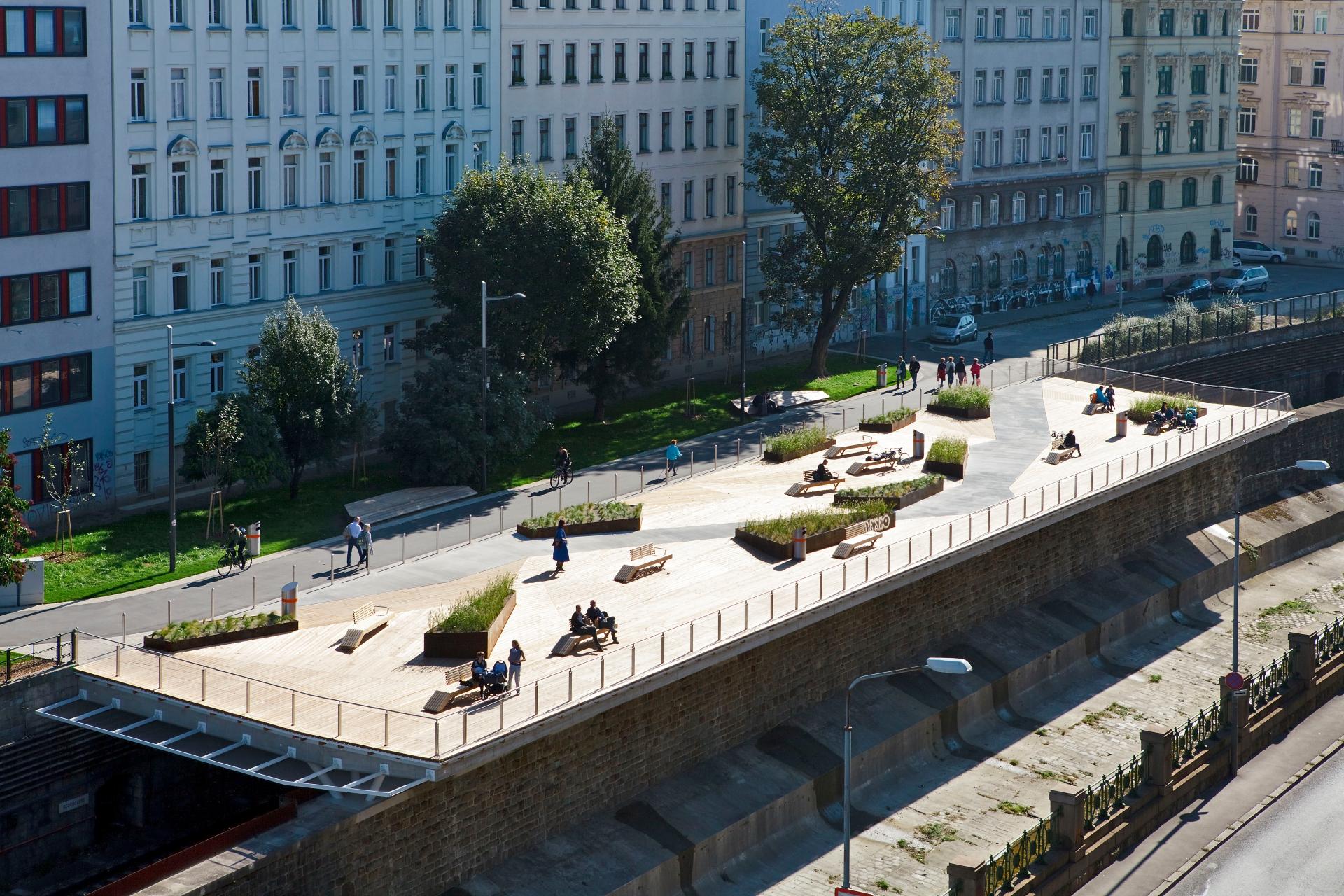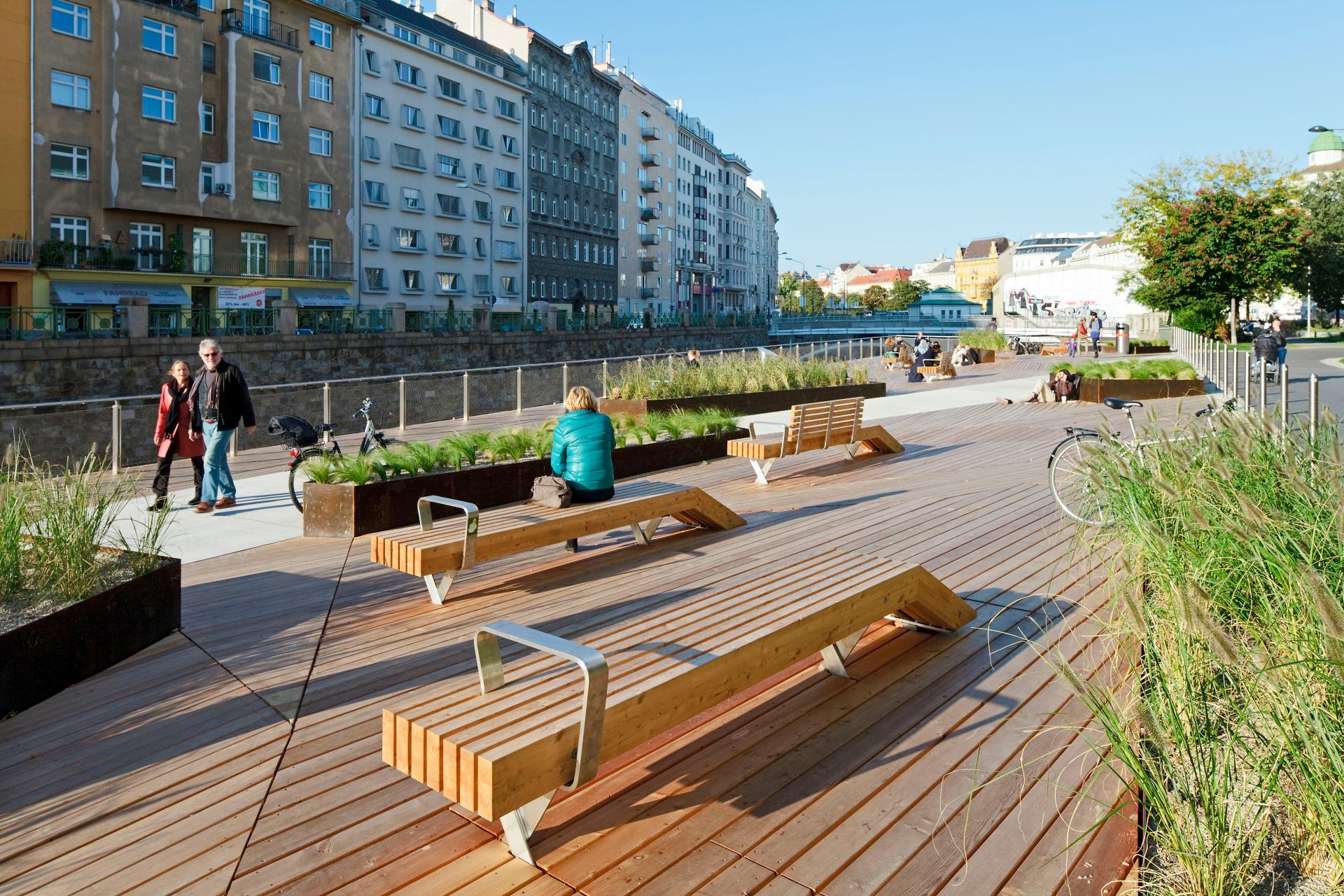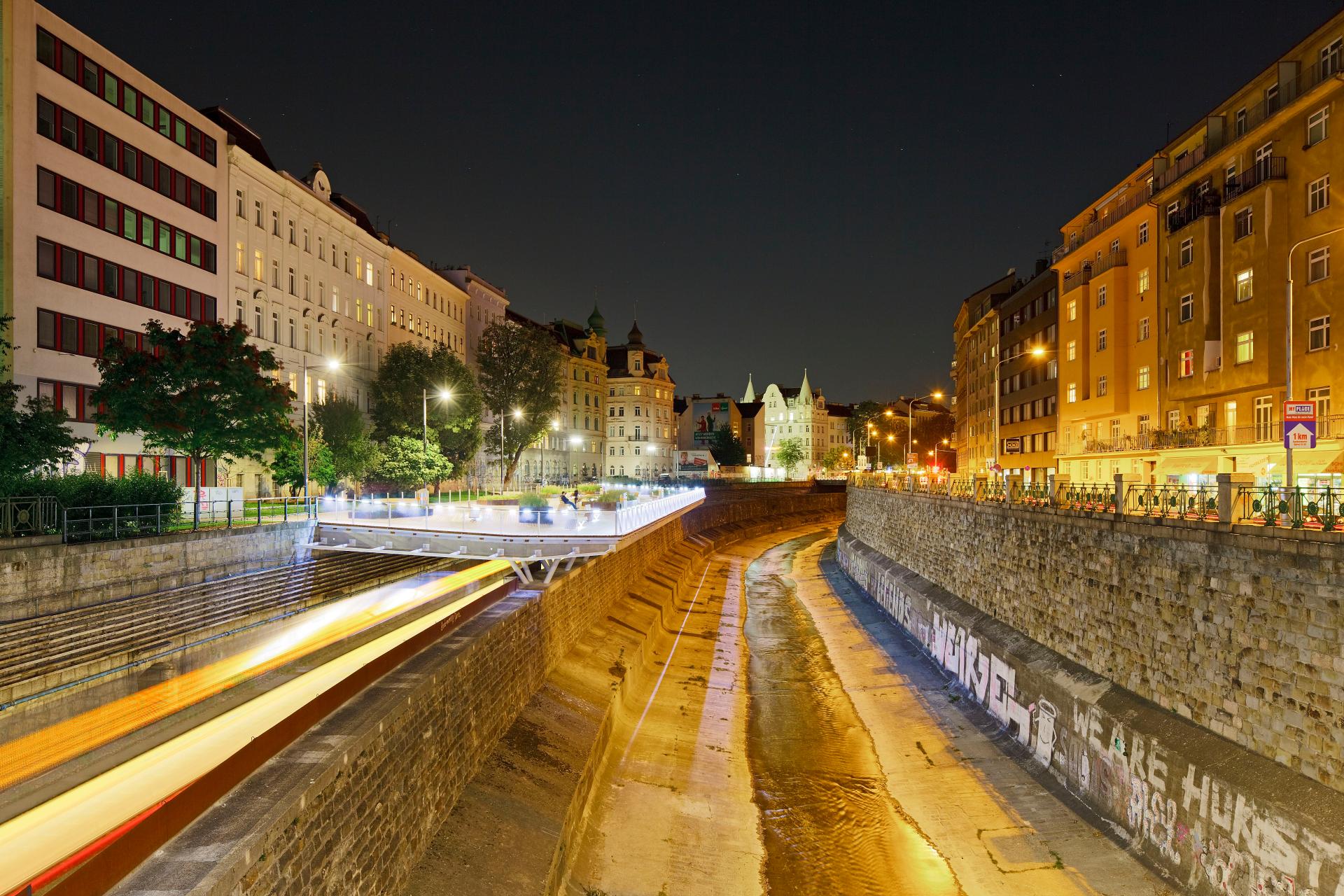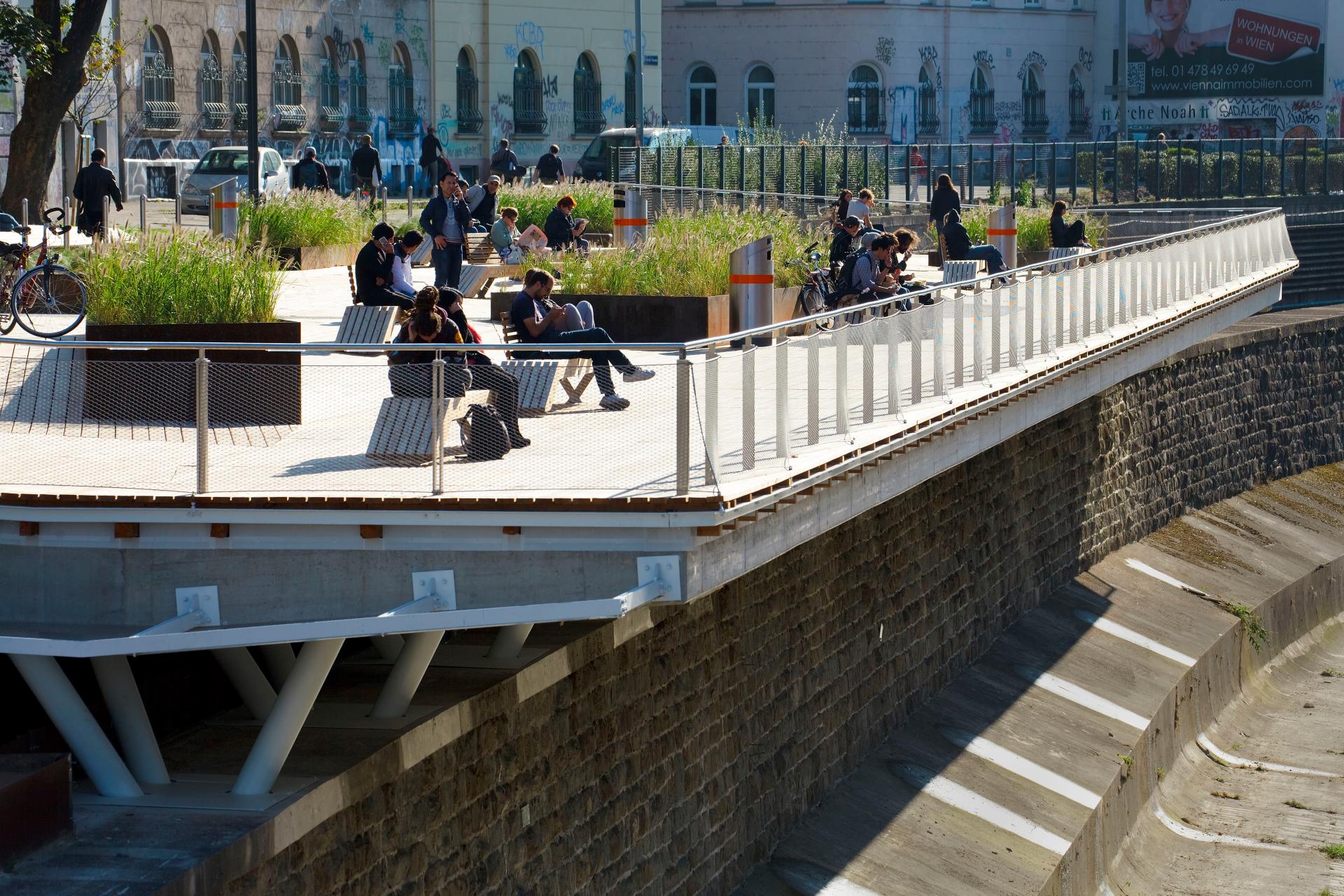Vienna Valley Terrace and footbridge
Basic information
Project Title
Full project title
Category
Project Description
The Vienna Valley Terrace is the first public terrace floating above an open subway line in Vienna. In a dense neighborhood the project adds over 2000 m2 of urgently needed public open space. As a unifying element it extends to the edge of the forgotten Wien River and makes it more tangible. The design evokes the proximity of water with a wooden deck for informal seating and high grasses for landscaping. The atmosphere supports urban leisure activities and a connection with nature.
Project Region
EU Programme or fund
Description of the project
Summary
A growing city like Vienna, requires more public open spaces with an attractive atmosphere for urban activities for its citizens . Vienna is one of the world’s greenest cities, however, the green spaces are unequally distributed in its 23 districts. The Vienna Valley Terrace is specifically designed as a response to the severe lack of public open space in the dense central city. The terrace and the footbridge over Wien River connect two districts and bring the river closer to the urban environment. The terrace is a catalytic project in the Vienna Valley Urban Development Plan and was the first of four public terraces conceived for the entire 14 km length of the river valley.
“A wood surface with integrated ramps folds into a terraced landscape, creating – despite the surrounding traffic – a place of rest in an environment that could hardly be more urban. The supports, the concrete slab and wood cladding are part of the holistic design that also includes benches and planters. In fact, the design elements and materiality – which are quite contemporary and sophisticated – invite public use, foster a positive connection with nature and water and conform to the technoid charm of the city railway designed by Otto Wagner: the beauty of utility”. Manuela Hötzl, architecture critic and writer, ORIS.
The project also includes a footbridge for pedestrians from the 6th district to safely cross Wien River and reach the terrace as well as the handicap accessible subway entrance. It is designed as a 33 m long and 5 m wide arched bridge..
The true testimony of the project’s success is the test of time. Whether looking for a place to meet friends, an open space to read a book, a seat to rest for some time, a beautiful public space to watch the sunset or an outdoor space for a late evening event, Vienna Valley Terrace has been a favorite destination to both Viennese and tourists. Thanks to its barrier-free characteristics, it is accessible to everyone at any time.
Key objectives for sustainability
Observing our cities, we find potentials that could be unlocked through smart interventions and creative ideas. Left-over spaces , inaccessible public land, degrading greenery and unused brownfields, are such opportunities. The idea of the Vienna Valley Terrace and the footbridge was based on a holistic sustainability approach, taking advantage of existing opportunities and enhancing the quality of degrading unused public space, by adding public space and landscaping to the 5th - 6th districts.. Our intervention unlocked the previously inaccessible and aesthetically unappealing public open space in front of the buildings and the terrace. By constructing the terrace and footbridge above a brownfield – subway line- we provided more than 2000 m2 of extra public space, 1.000 m2 on the terrace, another 1.000 m2 of reclaimed open space . An important element of the project is the extensive use of wood, an unusual floor-material in public open spaces in Austria.
To evaluate sustainability, the test of time and the LCC are highly relevant. The construction work of the Vienna Valley Terrace and the footbridge was completed in 2015. Since then, we have revisited the project regularly at different times on different occasions. Since our office is close to the site, we have been witnessing the life of the project since its completion. Five years have passed and still Viennese continuously use the terrace as a meeting point, a place to rest, read, watch the sunset, hang out with friends or simply be among others. It is usually a challenge to find an empty seat and sometimes an empty spot, but the wooden floor invites for seating on the entire terrace. This further proves that Vienna Valley Terrace is a popular public place and our cities need more of such places. Especially, during the last year with 3 lock-downs the terrace offered a welcome generous public space for the residents of the apartments without private open space.
Key objectives for aesthetics and quality
We believe that citizens are entitled to beautiful and inclusive public spaces where they can enjoy a welcoming atmosphere without consumption. The profile of the river Wien who gave the city its name, is a protected monument, but the river is hardly known to the citizens as it flows 10 meters below the street-level. This unique topography inspired the design for the Vienna Valley Terrace to float above a subway trench and overlook the Wien River. The terrace is inclined slightly towards the river to embrace its presence, make it more tangible, and ensure views of the water. Approaching the wooden deck, one embarks on a journey: stepping onto an inclined wooden surface, observing the city infrastructure – the subway – passing under one’s feet, walking by the irregularly shaped planters with wild grasses evoking natural river embankments, finally arriving at the edge where cityscape and waterscape meet. The choice of the material and design details such as the shape of the planters and the type of vegetation, are meant to awaken the senses and offer a moment of escape from stressful and noisy city life. During the last year citizens had to endure long and exhausting lockdowns due to the COVID-19 pandemic and the need for accessible open spaces became more urgent during the closure of all other public spaces.
The inspiration for the design was to remind citizens and visitors of the forgotten river Wien and to celebrate the proximity to water, while at the same time reclaiming public land from private use and from cars. The terrace was designed to offer a space for refuge and a break from busy city life in dense inner-city neighborhoods. For ecological and well-being reasons we chose the material wood from Austria which was used nearly on the entire surface of the deck and for the substructure. The sloping folded landscape is created by irregular triangular pieces and the planters are shaped to offer a natural frame for the high grasses, evoking the seaside.
Key objectives for inclusion
A project fostering inclusion, in the first place, responds to the immediate needs of its context. The Vienna Valley Terrace and footbridge were conceived in a dense urban context where the need for public open space could hardly be more perceptible.
The Vienna Valley Terrace is seen as a friendly and warm public open space thanks to its design and materiality. The visitors include a wide range of citizens from individuals, the youth, single households and students to young couples, families with kids and the elderly. The terrace has been hosting a wide range of activities such as silent disco, book signing and cultural events, 3-year-old kindergarteners practicing cycling on a sloped surface under safe conditions, group of friends playing guitar, families picnicking on a sunny day, and so on. It is a barrier-free structure and accessible to everyone without having to consume, it a open-minded public space. Based on our observation, the visitors feel quite comfortable in using the terrace on different occasions, for different purposes and in different ways. We have noticed that when the weather permits, the visitors spend quite a lot of time on the terrace and the seats are usually taken in no time. While the number of fixed seats is limited, with choosing wood as the floor material, we created a warm and comfortable atmosphere, comparable to a wooden deck by the sea or a pool. As a result, the users do not hesitate to find their preferred spot and sit on the floor. – alone or in groups. Especially young citizens appreciate the informal atmosphere which is highly untypical in a formal city like Vienna. Furthermore, in Vienna, many public spaces are dominated by cars or outdoor-seating from restaurants. The Vienna Terrace offers a stark contrast as only pedestrians and cyclists can reach it.
Results in relation to category
The Vienna Valley Terrace and footbridge also intervenes in its immediate vicinity. Formerly, the green strip adjacent to the buildings in front of the terrace, was blocked by high billboards. Consequently, this public space had been inaccessible and invisible to the public; it was used exclusively by two residents of one of the buildings. At the same time, since a street-widening project in front of the buildings was in the city-plans, there was a lack of interest in carrying out any interventions. Similar to a detective story, we found out that the plan to build the street is no longer valid and was given up by the authorities. Therefore, this area became the perfect place to implement an intervention that could reinvent the area and offer badly needed public open space. The high wall, had taken away a piece of public land and as a result, pedestrians and cyclists were left with a narrow walkway, which was uncomfortable and dangerous. By involving the residents in the design phase, we informed them of this potential and together, we imagined how an inaccessible left-over space could turn into a meeting-place for positive exchange, social and cultural urban activities. The idea was very well received by the residents who had been suffering from a lack of public open space in their neighborhood. The residents then convinced the elderly couple to relinquish the exclusive use of the garden and share with others. The participation of the neighbors further contributed to the active life of the project after its completion until today.
In summary, the reinvention of the place rests on three pillars: firstly, the reclaiming of a privately used garden, secondly the extension of the public space with a wooden terrace on an elegant steel structure cantilevering above an open subway trench, thirdly a pedestrian bridge that connects the terrace and the handicap accessible subway entrance with the other side of the river.
How Citizens benefit
The Vienna Valley is a major thoroughfare, in the past mostly for cars, but recently also for cyclists and pedestrians as one side of the river is flanked by a popular cycle path and a walkway connecting highly frequented subway stops. In the last years these paths have become overcrowded and at narrow points even dangerous. The lack of open space in the densely populated inner districts has caused an overuse of the few available parks. Therefore, the concept to create new open space was welcomed enthusiastically by the citizens and the local politicians of the adjacent districts.
The involvement of the citizens and stakeholders was addressed at different stages from the initial schematic design phase of the project until its completion and is ongoing in the use phase. a) Citizens from nearby districts benefit because they have no other green open spaces that can be used free of consumption. Thanks to the new footbridge, they can now safely cross the river and reach the handicap accessible subway entrance with an elevator without having to take long detours. b) The neighbors benefit because they were involved in the concept phase and strongly supported the reclaiming of public land for all to use. Formerly, the public property had been walled off with 4-meter high billboards and the space behind had been used exclusively by one renter. As a result, the space outside was negatively impacted through visual barriers and the narrowness of the walkway which had created a dangerous crossing of pedestrians and cyclists. c) Workshops were held at the local district office and all residents of the district were invited to participate and contribute ideas and wishes. For example, they asked for edible plants and fruit-trees and the avoidance of direct seating in front of their windows; these wishes were fulfilled. Especially young people enjoy the open-minded laissez-faire atmosphere of the space and sit on the wooden floor, lean on the planter boxes, study or play guitar.
Innovative character
The innovative character of the Vienna Valley Terrace lies within the very concept of the design and construction of a public terrace over a subway line on a brownfield-site. The terrace provides citizens with a public open space that emerged into the landscape and connects it to the adjacent buildings. It was the first of four terraces foreseen in the Vienna Valley Urban Development Plan, a plan which investigated the Vienna valley along its entire length regarding potential left-over spaces that could be reclaimed for public use and the creation of urgently needed open spaces.
The innovative aspect is also evident in the detailed design and materiality of the terrace. A cantilevered steel structure with a floating appearance above the subway line and the river bed. The riverbed of the Vienna Valley is a protected monument and any structure must be approved by the BDA – the Austrian national monument protection office – before it could be implemented. They required a floating structure for the terrace not to rest on the fragile river walls, already weakened by the subway construction. A requirement that was impossible to fulfill to the last letter, but the design concept with minimalized V-shaped steel columns, set back under the terrace, created the floating appearance the BDA wished for.
Initially, wood was considered a quite unusual material for an open public space in Vienna. We successfully managed to convince the authorities that wood is an excellent choice for this project due to its aesthetics, warm nature and sustainability aspect. As a result, the wooden deck was used for the first time in Austria in a public open space. As the first years of usage have passed, we are delighted that the users, the citizens for whom we designed the project love and use it entirely and claim every single spot. It makes it worth to have fought all the battles against the fears of wood as a dangerous and slippery material and to see the confirmation of our assumptions.




